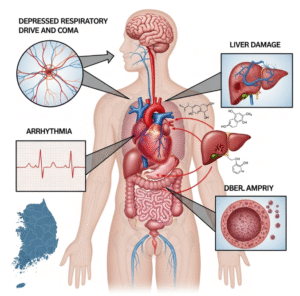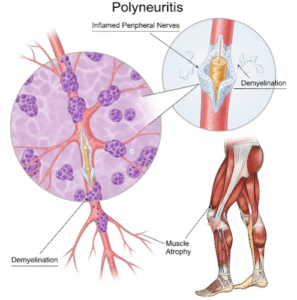Overview
Internuclear ophthalmoplegia (INO) is a neurological disorder affecting eye movement, characterized by impaired horizontal eye coordination. It results from damage to the medial longitudinal fasciculus (MLF), a neural tract that coordinates communication between the brainstem nuclei controlling eye muscles. INO causes difficulty in moving one eye inward (adduction), often accompanied by involuntary nystagmus (rapid, uncontrollable eye movements) of the opposite eye when looking sideways.
In Korea, patients with INO benefit from advanced neuroimaging techniques and specialized neurological rehabilitation programs, improving diagnosis and management outcomes.
What is Internuclear Ophthalmoplegia?
INO is a disorder of conjugate lateral gaze caused by a lesion in the MLF, which connects the abducens nucleus (controlling the lateral rectus muscle) to the oculomotor nucleus (controlling the medial rectus muscle). Damage disrupts this coordination, resulting in slowed or absent adduction of the affected eye during horizontal gaze. INO is often a sign of underlying neurological diseases, including multiple sclerosis and brainstem stroke.
Symptoms
Typical symptoms include:
- Difficulty moving one eye inward toward the nose (adduction deficit)
- Nystagmus in the abducting eye (the eye moving outward)
- Double vision (diplopia)
- Impaired horizontal gaze, especially side-to-side eye movement
- Sometimes mild disorientation or dizziness if brainstem involvement is extensive
Causes
Common causes of INO include:
- Multiple sclerosis (MS): The most common cause in young adults due to demyelination of the MLF
- Brainstem stroke: Particularly in older adults with vascular risk factors
- Traumatic brain injury affecting the brainstem
- Brainstem tumors or infections affecting neural pathways
- Rare causes include Wernicke’s encephalopathy and certain neurodegenerative diseases
Risk Factors
Risk factors vary by cause and include:
- For MS-related INO: young adulthood, female gender, family history of autoimmune diseases
- For stroke-related INO: hypertension, diabetes, smoking, high cholesterol, advanced age
- History of head trauma or neurological infections
- Immunosuppression or chronic neurological illness
Complications
INO itself is a sign of underlying neurological disease, so complications depend on the root cause and severity, such as:
- Persistent double vision impacting quality of life
- Progression of multiple sclerosis or recurrent strokes
- Balance and coordination problems if brainstem involvement extends
- Psychological distress due to visual impairment
Prevention
Preventive measures focus on managing underlying risks:
- Controlling vascular risk factors like hypertension, diabetes, and cholesterol
- Early diagnosis and management of multiple sclerosis
- Protecting against head injuries through safety measures
- Prompt treatment of infections and inflammation affecting the brain
Treatment Options in Korea
Diagnosis
Korean neurologists use advanced imaging modalities such as magnetic resonance imaging (MRI) to detect lesions in the medial longitudinal fasciculus. Visual field and eye movement assessments are performed to evaluate INO severity.
Medical Management
- Treatment targets the underlying cause: immunomodulatory therapies for MS, antiplatelets or anticoagulants for stroke, and antibiotics for infections.
- Symptomatic treatment includes prism glasses or occlusion therapy to manage diplopia.
- Rehabilitation programs help improve eye coordination and compensatory strategies.
Rehabilitation
- Specialized neuro-ophthalmology rehabilitation centers in Korea offer vision therapy, physical therapy, and occupational therapy to improve functional outcomes.
- Korean rehabilitation medicine integrates modern and traditional approaches, including acupuncture, to support neurological recovery.
Prognosis in Korea
Prognosis depends largely on the underlying cause. MS-related INO may improve with disease-modifying treatments but can be recurrent. Stroke-related INO outcomes depend on the extent of brainstem damage and rehabilitation success. Korea’s healthcare system provides comprehensive care enhancing recovery and quality of life.













